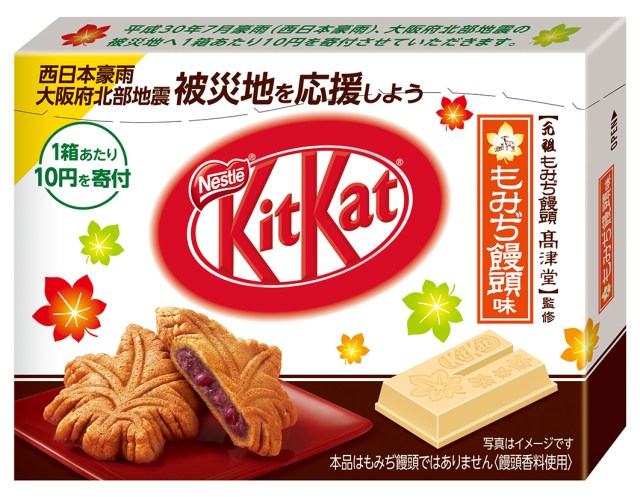disasters (Page 2)
This one of the best-tasting Kit Kat flavors out of Japan’s many exclusives, and it’s aiding the recovery of disaster-stricken Osaka and West Japan.
After dealing with a natural disaster, this part of Japan is now struggling to prevent financial disaster as well.
The shallow epicentre caused strong tremors that killed three and injured dozens of people in the region.
Out of 852 examined buildings in the city, researchers say the Shibuya fashion mecca is the least prepared for a major trembler.
Bright idea could keep you safe if an earthquake or typhoon leaves you without electricity.
The ports around the Chiba-area city of Choshi were last year honored for the fourth year in a row for having the largest catch of mackerel pike (a very popular fish known as sanma in Japanese) in Japan.
But that’s of little comfort to local fishermen who have this year found their boats stranded in a literal sea of garbage and debris that has been carried into the ports from the Tonegawa River. The heavy flooding of the Kanto region brought about by last week’s relentless rain is believed to be the cause of the sudden influx of waste.
Japan’s beautiful mountainous scenery and relaxing hot springs are all thanks to volcanic activity, and even today there are still a handful of active peaks to be found in the country. One of the most famous, Kyushu’s Mt. Aso, is even a popular tourist destination. We don’t recommend visiting today, though, because the 1,592-meter (5,223-foot) volcano is currently erupting, as seen in these photos taken by locals.
If volcanoes were comic or fantasy villains, they’d be more akin to Marvel’s cosmic entities or Lovecraftian horrors than the puny likes of Magneto or, uh… The Slug (I don’t know many Marvel villains). They strike only every few thousand years before slipping back into a long slumber, lurking for centuries as humanity slowly forgets the horrors they can inflict, inching closer to the looming mountains with each passing year, setting up cities at their very feet. Then, when mankind least expects it – just chillin’ ‘n shit as Dave Chappelle might say – the volcano strikes again, blasting molten rock and ash over miles and miles, smothering out whole cities in the (cosmically speaking) blink of an eye.
Yet, even as we know intellectually that volcanoes are kind of a big deal, we tend to look up at them less with abject horror and awe and more with shouts of, “Hey, check out that big-ass rock!”
Well people, we’ve got news for you: There are at least six big-ass rocks capable of blotting out not just entire cities, but entire civilizations and possibly humanity itself and you’ll never guess which disaster-prone island nation has the most.
We recently celebrated Instant Ramen Day, marking 56 years since the very first packs of easy-to-cook noodles appeared in Japan. Not every anniversary that comes at this time of year is so lighthearted though. On September 1, 1923, the Great Kanto Earthquake struck the Tokyo area, resulting in the death or disappearance of some 140,000 people.
Out of respect to the fallen and concern for the living, in 1960 the Japanese government designated September 1 as Disaster Preparedness Day, and this year we put together a disaster kit assembled from items you can easily procure at the 100-yen store.
In the early hours of the morning on August 20, Hiroshima City was hit by severe thunderstorms. As the downpour continued, the ground gave way in the Asanami and Asakita Wards, triggering landslides that have caused the deaths of dozens of residents.
With the storm finally passed and clean-up projects beginning, we visited the disaster site where we saw just how long the road to recovery is going to be.















 7-Eleven Japan’s ramen-cooking robot whipped us up a bowl of noodles【Taste test】
7-Eleven Japan’s ramen-cooking robot whipped us up a bowl of noodles【Taste test】 The 5 best Japanese bento to buy at Kyoto Station
The 5 best Japanese bento to buy at Kyoto Station Photos from 140 years ago show Tokyo’s skyline was amazing long before the Skytree was ever built
Photos from 140 years ago show Tokyo’s skyline was amazing long before the Skytree was ever built Japanese avoiding domestic travel as foreign tourists increase, possibly creating vicious cycle
Japanese avoiding domestic travel as foreign tourists increase, possibly creating vicious cycle We suspected this Japanese cable car was an overpriced tourist trip, but we underestimated it
We suspected this Japanese cable car was an overpriced tourist trip, but we underestimated it The 10 best day trips from downtown Tokyo【Survey】
The 10 best day trips from downtown Tokyo【Survey】 Is this the most relaxing Starbucks in Japan?
Is this the most relaxing Starbucks in Japan? 7-Eleven Japan starts new temporary luggage storage service in over 300 branches
7-Eleven Japan starts new temporary luggage storage service in over 300 branches What does three months of Yoshinoya beef bowls do to your body? Medical study announces results
What does three months of Yoshinoya beef bowls do to your body? Medical study announces results How to make a Big Mac in Tokyo at a fraction of the price with minimal effort【SoraKitchen】
How to make a Big Mac in Tokyo at a fraction of the price with minimal effort【SoraKitchen】 Disillusionment at Tsukiji’s tourist-target prices led us to a great ramen restaurant in Tokyo
Disillusionment at Tsukiji’s tourist-target prices led us to a great ramen restaurant in Tokyo Starbucks teams up with 166-year-old Kyoto doll maker for Year of the Horse decorations【Photos】
Starbucks teams up with 166-year-old Kyoto doll maker for Year of the Horse decorations【Photos】 Japan may add Japanese language proficiency, lifestyle classes to permanent foreign resident requirements
Japan may add Japanese language proficiency, lifestyle classes to permanent foreign resident requirements Starbucks Japan releases new zodiac chilled cup drink for 2026
Starbucks Japan releases new zodiac chilled cup drink for 2026 Lacquerware supplier to emperor of Japan and Pokémon team up for new tableware
Lacquerware supplier to emperor of Japan and Pokémon team up for new tableware Tokyo’s Tsukiji sushi neighborhood asks tour groups to stay away for the rest of the month
Tokyo’s Tsukiji sushi neighborhood asks tour groups to stay away for the rest of the month Starbucks on a Shinkansen bullet train platform: 6 tips for using the automated store in Japan
Starbucks on a Shinkansen bullet train platform: 6 tips for using the automated store in Japan Street Fighter Hadouken Churros to be launched and eaten in Tokyo, Okami pudding on offer too
Street Fighter Hadouken Churros to be launched and eaten in Tokyo, Okami pudding on offer too Japan’s human washing machines will go on sale to general public, demos to be held in Tokyo
Japan’s human washing machines will go on sale to general public, demos to be held in Tokyo Japanese train company is letting fans buy its actual ticket gates for their homes
Japanese train company is letting fans buy its actual ticket gates for their homes Tokyo considering law requiring more trash cans following litter increase in heavily touristed area
Tokyo considering law requiring more trash cans following litter increase in heavily touristed area Nintendo’s Kirby now delivering orders at Kura Sushi restaurants, but not in Japan
Nintendo’s Kirby now delivering orders at Kura Sushi restaurants, but not in Japan Tokyo event lets you travel back in time, for free, to celebrate 100 years since Showa era start
Tokyo event lets you travel back in time, for free, to celebrate 100 years since Showa era start Sanrio theme park in Japan announces plans to expand into a Sanrio resort
Sanrio theme park in Japan announces plans to expand into a Sanrio resort Survey asks foreign tourists what bothered them in Japan, more than half gave same answer
Survey asks foreign tourists what bothered them in Japan, more than half gave same answer Japan’s deadliest food claims more victims, but why do people keep eating it for New Year’s?
Japan’s deadliest food claims more victims, but why do people keep eating it for New Year’s? We deeply regret going into this tunnel on our walk in the mountains of Japan
We deeply regret going into this tunnel on our walk in the mountains of Japan Studio Ghibli releases Kodama forest spirits from Princess Mononoke to light up your home
Studio Ghibli releases Kodama forest spirits from Princess Mononoke to light up your home Major Japanese hotel chain says reservations via overseas booking sites may not be valid
Major Japanese hotel chain says reservations via overseas booking sites may not be valid Put sesame oil in your coffee? Japanese maker says it’s the best way to start your day【Taste test】
Put sesame oil in your coffee? Japanese maker says it’s the best way to start your day【Taste test】 The top 10 annoying foreign tourist behaviors on trains, as chosen by Japanese people【Survey】
The top 10 annoying foreign tourist behaviors on trains, as chosen by Japanese people【Survey】 No more using real katana for tourism activities, Japan’s National Police Agency says
No more using real katana for tourism activities, Japan’s National Police Agency says Starbucks Japan reveals new sakura drinkware collection, inspired by evening cherry blossoms
Starbucks Japan reveals new sakura drinkware collection, inspired by evening cherry blossoms The 10 best day trips from downtown Tokyo【Survey】
The 10 best day trips from downtown Tokyo【Survey】 Is this the most relaxing Starbucks in Japan?
Is this the most relaxing Starbucks in Japan? 7-Eleven Japan starts new temporary luggage storage service in over 300 branches
7-Eleven Japan starts new temporary luggage storage service in over 300 branches What does three months of Yoshinoya beef bowls do to your body? Medical study announces results
What does three months of Yoshinoya beef bowls do to your body? Medical study announces results How to make a Big Mac in Tokyo at a fraction of the price with minimal effort【SoraKitchen】
How to make a Big Mac in Tokyo at a fraction of the price with minimal effort【SoraKitchen】 Lacquerware supplier to emperor of Japan and Pokémon team up for new tableware
Lacquerware supplier to emperor of Japan and Pokémon team up for new tableware Nearly half of young Japanese men in survey have never had a girlfriend, zero-boyfriend women rise too
Nearly half of young Japanese men in survey have never had a girlfriend, zero-boyfriend women rise too Dragon Quest Burgers and Slime drinks are coming to McDonald’s Japan【Video】
Dragon Quest Burgers and Slime drinks are coming to McDonald’s Japan【Video】 The etiquette rules for visiting Shinto shrines in Japan
The etiquette rules for visiting Shinto shrines in Japan Starbucks Japan releases new zodiac chilled cup drink for 2026
Starbucks Japan releases new zodiac chilled cup drink for 2026 This hot springs town in Japan sets fire across a mountain every winter in a beautiful tradition
This hot springs town in Japan sets fire across a mountain every winter in a beautiful tradition Drunk cycling can result in an instantly suspended driver’s license in Japan
Drunk cycling can result in an instantly suspended driver’s license in Japan